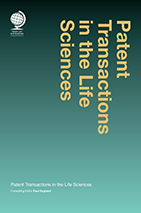Compensating employee inventors
January 2014
In the life sciences, highly qualified and skilled people are employed in the research and development of new drug candidates and other advancements associated with therapy. The results of such work will often be inventions which the employer can patent and directly commercialise, benefitting from the exclusivity the patent allows, or which contribute to the development of a marketable product. The question therefore often arises whether the employed inventor is able to share in the benefits derived from the patenting of their work and, if so, how is this benefit determined. The rules on this area diverge widely between different countries. Here we explain the rules in Austria, Germany and the UK.

This article contains extracts from the forthcoming book Patent Transactions in the Life Sciences (Globe Law and Business Publishing, August 2014).
Austria
Introduction
As will be seen, the protection of the rights of employed inventors is an immediate and detailed concern of the Austrian Patent Law.
As a general rule the inventor is the person entitled to the grant of a patent, even if the invention was made while the inventor was employed (see Who is entitled to a patent?). But employer and employee can agree on different terms. In this case the employer is the one entitled to the grant of a patent. In return the employer has to compensate the employee for the invention.
If the employment is governed by public law, the employer may claim an employee´s invention even without agreement. In this case the employee may claim an adequate compensation according to the general rules.
According to Austrian Patent Law, employees are entitled to an adequate, special compensation for assigning an invention made by the employee or granting the right to use such an invention to the employer. This special compensation has to be paid in addition to ordinary salaries/wages. If, however, an employee is explicitly hired for and occupied with inventive activities that led to the invention, no extra compensation has to be granted to the employee, as far as the salary already comprises an adequate compensation.
An employer is obliged to pay this compensation when he claims the right to the invention.
Assessment
The assessment of compensation is of practical importance. According to the Austrian Patent Law the circumstances of each individual case have to be considered. The law itself states the factors that must be considered:
- The economic importance of the invention to the enterprise has to be valued;
- Any other exploitations of the invention, regardless of whether they take place in Austria or abroad have to be taken into account; and
- The extent to which the support of the enterprise with its resources, incentives, experience, preliminary work and internal instructions contributed to the invention.
 As the Austrian Supreme Court quite recently emphasized1, the Austrian legislator has not set up a fixed set of rules for the exact assessment of compensation as such rules could never deliver just results in each individual case. Consequently, each case has to be judged according to its specific, including economic, circumstances.
As the Austrian Supreme Court quite recently emphasized1, the Austrian legislator has not set up a fixed set of rules for the exact assessment of compensation as such rules could never deliver just results in each individual case. Consequently, each case has to be judged according to its specific, including economic, circumstances.
The value of the invention as a measure of the economic importance to the particular enterprise (usually estimated with view to a hypothetical procurement value) taking into account the particular exploitation envisaged is reduced according to the extent of the support/contribution of the enterprise. An invention’s value can vary significantly for different enterprises, even in the same sector of industry.
The preferred method to assess the value of an invention is to compare it with licences. Alternatively the assessment has to be based on a calculation of the internal benefit of the invention. If both of these methods fail to deliver results, an estimate has to be made:
Licences: licence fees are expected to directly correlate with the net turnover of the product manufactured using the invention and the portion of product value owed to the contribution of the invention. If the employer has licensed the invention to a third party the terms of the licence agreement will be significant for the assessment of compensation in most cases. Alternatively, if there is no such licence agreement with a third party, average values for the specific industry sector in question have to be applied.
As inventions will usually only effect single parts or aspects of goods sold or processes used, the compensation is to be calculated based only on the portion of the net turnover the invention actually contributes to.
Internal benefit: a determination of the internal benefit takes into account the costs caused by the implementation of the invention as well as the reduction of costs the invention led to in return. The inventor is entitled only to a remuneration representing a portion of these savings in costs as the benefit has to be split up between employer and employed inventor.
Estimation: if both above mentioned methods can’t be used, in the last resort an estimation has to be made. Thereby, inter alia, the amount the enterprise would have had to spend for such an invention on the market has to be taken into account.
Circumstances, e.g. whether the invention significantly strengthens the market position of the employer can have an impact on determining the amount of the actual compensation.
Contribution/Support of the enterprise: after the value of the invention is calculated, as required by the Austrian Patent Law, the contribution of the enterprise to the invention has to be taken into account. Thus a reducing factor has to be assessed which is then to be multiplied with the value of the invention. Different sub-factors, e.g. the incentive for the invention and the extent to which the resources of the enterprise contributed to the achieving of the invention are aggregated to form this reducing factor.
If several employees jointly make an invention, each person’s share has to be determined and for each individual the reducing factor can be different.
Subsequent changes
 As parameters essential for the assessment of the compensation can change over time, the originally determined figure can be adapted later in case conditions change substantially. Any party - the inventor as well the enterprise - can demand such a reassessment. A revaluation can affect only future payments: on the one hand, the inventor is never obliged to refund payments he already received; on the other hand, compensations already paid or due do not have to be supplemented, except when the compensation consists of only a single payment.
As parameters essential for the assessment of the compensation can change over time, the originally determined figure can be adapted later in case conditions change substantially. Any party - the inventor as well the enterprise - can demand such a reassessment. A revaluation can affect only future payments: on the one hand, the inventor is never obliged to refund payments he already received; on the other hand, compensations already paid or due do not have to be supplemented, except when the compensation consists of only a single payment.
In cases where an invention is assigned from the enterprise to a third party and the resulting revenue for the enterprise is excessively disproportionate to the assessed compensation, the employee can demand a reassessment.
Variable compensation
Variable compensation regimes can be agreed. If the employer and the employee agree upon a compensation linked to the extent to which the enterprise exploits the invention but the enterprise does not exploit the invention to an extent adequate to the economic importance of the invention to the enterprise, e.g. when the invention is licensed under-price to another company within the group, the inventor is protected by a legal fiction. This is that the compensation has to be calculated on the basis of a hypothetical extent of exploitation commensurate with the economic importance of the invention. The same rule applies if the invention is assigned to a third party without the agreement of the inventor.
The employer can exempt himself from this obligation to compensate the employee, provided he undertakes to grant the right to use the invention to a third party which is to be designated by the inventor.
If the specific circumstances do not allow exploitation to an extent greater than that actually realized, the compensation must reach the level that would be expected from the importance of the invention. If, however, the employer benefits from the invention without using it, he has to compensate to an adequate extent.
Sometimes an employer may decide not to use an employee’s invention when the employer plans to use the invention not now but in the future or when the employer primarily wants to exclude competitors from the use of this invention. If the patent excludes competitors from using the invention while the employer uses an alternative to the employee’s invention, the value of the alternative invention used should be considered when assessing the value of the employee’s invention.
Mandatory law
The rights of employees constituted by the Austrian Patent Law are independent of termination of the employment and can neither be limited nor revoked by any agreement.
Germany
 An employee inventor is compensated once the patent has been granted and has an economic value for the employer. The most common method for calculating employee inventor compensation is yearly royalties until the patent lapses – alternatively, lump sum payments can be agreed upon. When calculating yearly royalties, several factors are taken into account: The net sales of the product (which net sales were generated in a year?), the contribution ratio of the inventor (was he the sole inventor?), a common royalty amount (what royalties are "customarily" paid, i.e. what share does the invention have with a view to the product?) and the employee's personal share in the invention (did the company motivate the invention, or did the inventor come up with the invention on his own).
An employee inventor is compensated once the patent has been granted and has an economic value for the employer. The most common method for calculating employee inventor compensation is yearly royalties until the patent lapses – alternatively, lump sum payments can be agreed upon. When calculating yearly royalties, several factors are taken into account: The net sales of the product (which net sales were generated in a year?), the contribution ratio of the inventor (was he the sole inventor?), a common royalty amount (what royalties are "customarily" paid, i.e. what share does the invention have with a view to the product?) and the employee's personal share in the invention (did the company motivate the invention, or did the inventor come up with the invention on his own).
The UK
If the invention made by an employee inventor belongs to the employer (see Who is entitled to a patent?), the employee may nonetheless be entitled to compensation. This requires there to be an outstanding benefit to the employer and that compensation is just in the circumstances2. Until relatively recently, no employee had successfully claimed the right to compensation for the benefit their work had brought to their employer3. The reason for this was the difficulty of satisfying the former requirement of the Patents Act that it is only the patent for the invention that must have the outstanding benefit for the employer, as opposed to the invention. The Patents Act 1977 has now been amended to expressly state that the outstanding benefit can be derived from both. If such outstanding benefit can be demonstrated, the court must secure for the employee “a fair share (having regard to all the circumstances)” of the benefit the employer has derived or may reasonably be expected to derive from the invention or the patent for the invention, including from its assignment or license.
Difficulty arises in establishing what an “outstanding benefit” and “a fair share” is. In James Duncan Kelly,“outstanding” was held to mean “something special” or “out of the ordinary”; more than merely “substantial”, “significant” or “good”. However, the judge did not think it necessary to demonstrate that the patent's benefit in that case could not be exceeded. The judge considered that the meaning of “fair share” depended on the evidence available, but that it should not be thought of in the same way as loss or damage, or seek to put the inventor in the same position as an external patentee.
 In Unilever Plc and Ors v Ian Alexander Shanks4, the Court of Appeal had to decide how an employee inventor should be compensated if the benefit of their invention had accrued not to their employer, but to a third party to whom rights in the invention has been transferred. In Unilever, the inventor's employer, Unilever UK Central Resources, assigned the patent on the invention to another group company, Unilever Plc. The assignment was made for a nominal sum, but Unilever Plc then licensed the patent in exchange for the payment of royalties totalling approximately £23 million. The inventor claimed that had his invention been licensed sooner it would have raised closer to £1 billion in royalties. The question for the court was whether the sum the inventor was entitled to in compensation should be based on the actual amount made by the licence to the patent or the hypothetical amount that the licence could have made. The Court held that the inventor should receive a sum based on the amount of £23m that was actually paid, not a hypothetical sum.
In Unilever Plc and Ors v Ian Alexander Shanks4, the Court of Appeal had to decide how an employee inventor should be compensated if the benefit of their invention had accrued not to their employer, but to a third party to whom rights in the invention has been transferred. In Unilever, the inventor's employer, Unilever UK Central Resources, assigned the patent on the invention to another group company, Unilever Plc. The assignment was made for a nominal sum, but Unilever Plc then licensed the patent in exchange for the payment of royalties totalling approximately £23 million. The inventor claimed that had his invention been licensed sooner it would have raised closer to £1 billion in royalties. The question for the court was whether the sum the inventor was entitled to in compensation should be based on the actual amount made by the licence to the patent or the hypothetical amount that the licence could have made. The Court held that the inventor should receive a sum based on the amount of £23m that was actually paid, not a hypothetical sum.
19 ObA 24/13i of June 25, 2013
3See James Duncan Kelly and Kwok Wai Chiu v GE Healthcare Limited [2009] EWHC 181 (Pat)
If you have any questions on this article or would like to propose a subject to be addressed by Synapse please contact us.


Bernhard is an associate in the Trade Marks & Designs group based in our Vienna office.

Rainer
Schultes

Dr Manja
Epping
Manja is a partner and Head of Life Sciences for Germany based in our Munich office.

Paul England
Paul is a senior associate and professional support lawyer in the Patents group based in our London office.
"…the protection of the rights of employed inventors is an immediate and detailed concern of the Austrian Patent Law."


